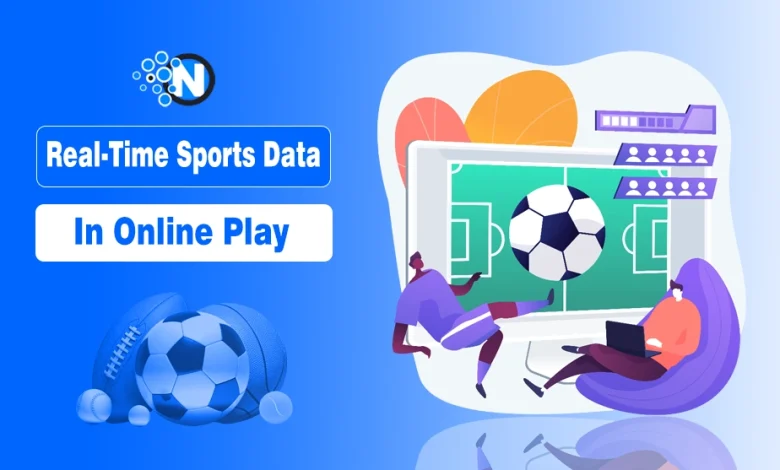Real-Time Sports Data in Online Play: The Future of Online Gaming

Have you ever experienced that when you watch a game online, you try to make strategic betting moves as the suspense takes place? It is not important that you only bet; some people just enjoy and start debating on the next move when they see the stats and real-time data.
This real-time sports data in online gaming turns some passive viewers into active participants. I have chatted with some of my friends who bet on everything from the NFL to Aussie Rules, and I’ve seen how instant stats revolutionize the experience. It’s not just about scores anymore, it’s live insights that make you feel part of the game, no matter where you are.
Real-time sports data in online gaming bridges the gap between watching and playing. And that is the reason nowadays, this debate is so popular that real-time sports stats are the future of online gaming. If that is the case, then let’s discuss how it is and how it’s changing play.

What is Real-Time Sports Data?
Real-time sports data is the information regarding a live sports event that is recorded, processed, and made available to users with as little delay as possible. In most cases, it would be a matter of milliseconds to several seconds as the action takes place on the field.
Unlike delayed or post-game statistics, this real-time data feed is necessary in applications where real-time matters. This can be for various reasons, such as real-time betting, live coaching, and other interactive fan experiences.
For market research and audience expectations, consumer guides to live formats on reputable directories such as top social casinos can help teams benchmark interaction models and session pacing against what players already enjoy.
Key Components
Sports information and data offered on a real-time basis contain a large range of metrics and stats:
- Core Game Events: There are live scores, play-by-play events, such as pass-by-passing, the events of goals, shots, fouls, replacements, and penalties.
- Player and Ball Tracking Data: It provides positional data for players and the ball at every time sample, which makes it possible to calculate speed, distance covered, acceleration, shot trajectory, and spatial relationships.
- Contextual Data: A Set of facts about the conditions of the venue, weather, whether it is substitution time, or some situational match data.
How Real-Time Data is Revolutionizing Online Gaming?
Teams use real-time sports data for in-game changes. You may have seen coaches swap players based on fatigue metrics from wearables. In online gaming, this translates into dynamic simulations that your virtual team adjusts in real time.
For players, it means personalized stats. Nowadays, as technology advances, AI analyzes your style and suggests moves while gaming. This edge keeps games fair and thrilling. I have also felt the rush when my AI coach tweaks my lineup mid-match, turning a loss into a comeback. This ultimately helps in playing smarter.
Fan Engagement on Steroids
Fans crave immersion, and I know this because my friend once bet while watching shot-by-shot overlays. Real-time sports data powers quizzes and predictions, keeping the audience glued to their screens.
I have also seen AR displays in some gaming zones showing visual metrics such as sprint speed. You can also try some apps with heatmaps; it will feel like coaching. The interactivity pulls you in. I have joined live polls during a soccer match, voting on the next play, and the engagement skyrockets.
Betting Gets Personal and Fast
Latency kills bets. Live data syncs odds instantly. Prediction markets thrive on it, letting you bet on niche events such as substitutions.
Personalization is another thing; just take it to a high level. If you are also in this game, then you may have sometimes received tailored odds based on my betting history. This is here to make every wager feel custom. It’s addictive enough to turn casual fans into loyal ones.
Tech Powering the Shift
Now I will discuss the major factors that are empowering the shift in real-time sports data:
AI and Interactive Features
AI overlays stats on streams. I am also a game lover, and I have personally experienced basketball apps showing shooting ranges, which boosts engagement. Gamified quizzes during games also keep the audience engaged.
Some of the platforms are working on integrating this for immersive play.
The AI learns too. Gamers nowadays also have apps that adjust difficulty based on skill, making games challenging yet fun. It’s like having a smart opponent. You will also experience live commentary APIs narrating plays.
Prediction and Personalization
Live APIs deliver scores and odds. People have also used them not only for gaming but also for trading perspectives for fantasy trades, such as spotting trends instantly. AI tailors content for you, like notifications for favorite players. It’s an addictive session length that soars.
Personalized feeds keep me hooked. I have gotten alerts for my team’s highlights, and that helps pull me back for more. It’s data making gaming feel made for me. Predictive modeling spots bottlenecks.
The Future of Online Gaming with Real-Time Data
The future of real-time data online gaming is in developing more intelligent and entertaining experiences. This involves the hyper-personalization of digital games and their content according to personal preferences and ability. This is possible with processing real-time information only, and this can be processed by AI.
This leads to increased immersion, particularly in AR/VR, where low latency is necessary for realism. The developers have the advantage of real-time information on player behaviour to optimize operations. The gaming industry, with the support of improved network speeds, is transforming into a digital universe with high responsiveness, adaptability, and fluid connectivity, providing each user with a personalized experience.
Final Thoughts: Where Sports Data Meets Digital Play
Real-time sports data is transforming online gaming by enhancing fan engagement, personalizing betting experiences, and utilizing advanced technology. It enables players to feel truly immersed in the game by providing instant stats and insights.
This helps in boosting a dynamic and interactive environment. With the integration of AI and predictive modeling, every interaction becomes tailored and exciting, turning casual viewers into active participants. As I look to the future, the evolution of these technologies is creating an even more engaging and personalized online gaming landscape, making each moment count in the world of sports.




